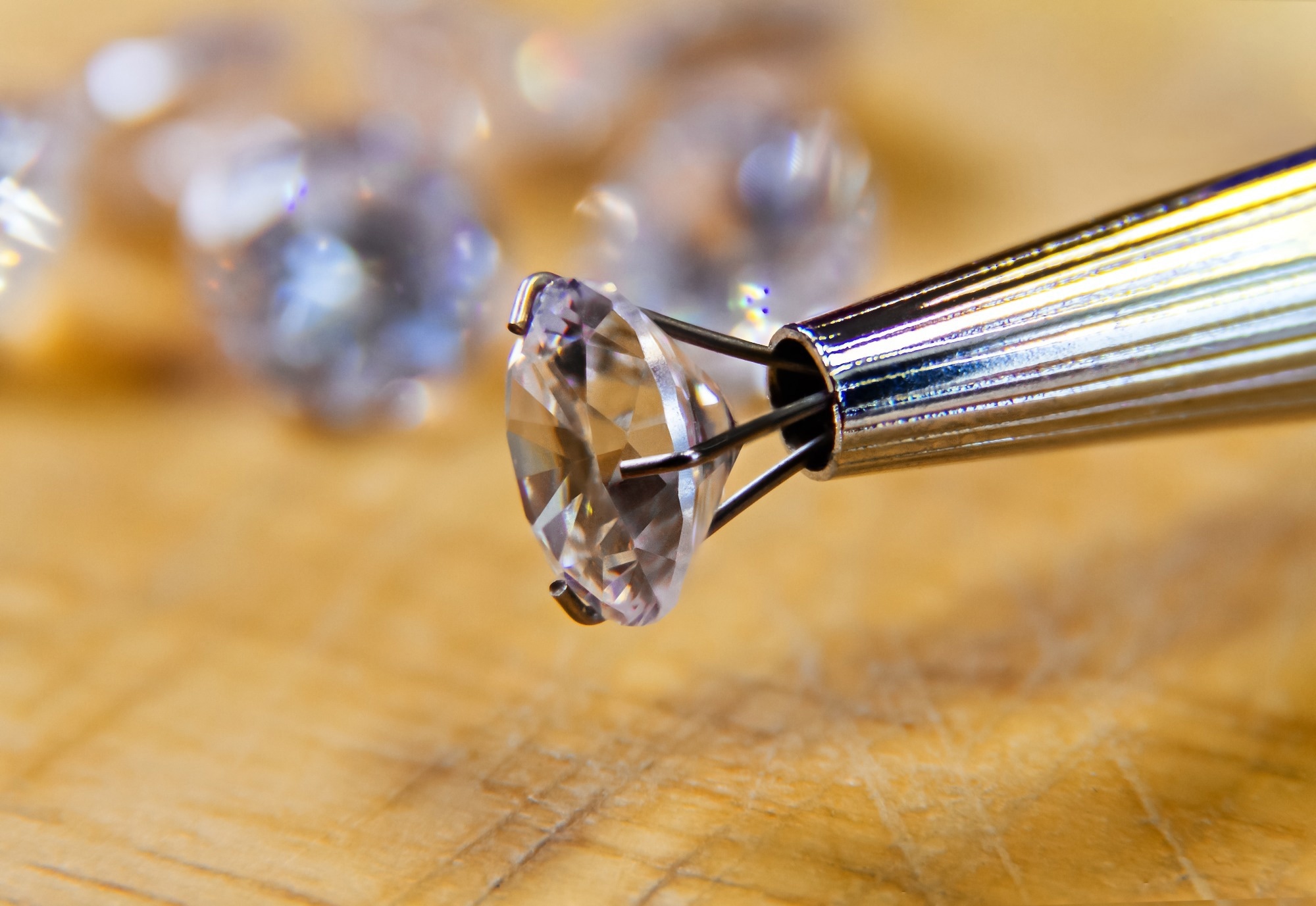 By Owais AliReviewed by Lexie CornerOct 22 2024
By Owais AliReviewed by Lexie CornerOct 22 2024Synthetic or lab-grown diamonds are artificially created gems with the same chemical composition and crystal structure as natural diamonds. They can be engineered with specific optical and mechanical properties, making them valuable for jewelry and industrial applications.

Image Credit: Roma Likhvan/Shutterstock.com
Diamonds form deep within the Earth's mantle, around 250 kilometers below the surface, where immense pressure (up to 10 GPa) and temperatures (around 2,200 °C) compress carbon into diamonds over billions of years. This lengthy formation process adds to their value, yet the growing demand for diamonds in various applications necessitates alternatives.
Consequently, researchers have turned to synthetic diamonds, offering a cheaper, sustainable, and ethical option that meets industry needs while reducing environmental impact.1
What Are Lab-Grown Diamonds Made Of?
Lab-grown diamonds are chemically and structurally identical to natural diamonds, consisting of carbon atoms arranged in a crystal lattice. Unlike diamond alternatives like cubic zirconia or moissanite, which mimic only the appearance of diamonds, synthetic diamonds are physically and optically real diamonds.
While natural diamonds take billions of years to form, synthetic diamonds can be created in a few weeks. This rapid production, combined with lower costs and reduced environmental impact, has fueled their popularity in both consumer markets and high-tech industries.
The two main methods for creating lab-grown diamonds are high-pressure high temperature (HPHT) and chemical vapor deposition (CVD). Both processes occur in controlled laboratory environments, enabling precise manipulation of conditions to achieve specific characteristics, including size, color, and clarity.1,2
Method 1: High-Pressure High-Temperature (HPHT)
HPHT was the first industrial method used to produce synthetic diamonds. It replicates the conditions under which natural diamonds form within the Earth.
In this process, carbon is placed in a chamber with a diamond seed and a metal catalyst like nickel, cobalt, or iron, which helps reduce the temperature needed for diamond formation. The chamber is subjected to extreme pressures (up to 870,000 psi) and high temperatures (1,300 to 1,600 °C). Under these conditions, carbon dissolves into the metal catalyst and then crystallizes around the diamond seed, forming a synthetic diamond.3
Advantages and Disadvantages of HPHT Diamonds
HPHT diamonds are valued for their hardness and durability, making them ideal for high-pressure applications. For example, polycrystalline diamond (PCD) produced through the HPHT method is a superhard material widely used in PDC drill bits. It provides exceptional hardness, wear resistance, and improved penetration rates, making it ideal for demanding oil and gas drilling applications.
However, HPHT diamonds often contain metallic inclusions from the growth catalysts, reducing clarity and limiting their use in high-end jewelry. The internal stress caused by the extreme formation conditions can also lead to strain in the crystal lattice, affecting its integrity for applications requiring defect-free crystals.
Additionally, impurities like nitrogen can result in color variations, such as yellow diamonds, which may be less desirable for jewelry and optical applications.4,5
Industrial Landscape of HPHT Diamonds
Despite these challenges, HPHT remains a key method for producing synthetic diamonds, especially for industrial applications.
Companies like Hyperion Materials & Technologies use this technology to manufacture diamond-based composites such as Versimax™ and Compax™. These composites offer exceptional corrosion and wear resistance at high temperatures, along with high-strength properties comparable to cobalt-sintered PCD and improved thermal stability.
These materials are widely used in metal forming, wire drawing applications, and high-pressure research environments, including geothermal studies. Their hardness and durability also make them essential in the mining and drilling sectors, particularly for oil and gas extraction.6
Method 2: Chemical Vapor Deposition (CVD)
The chemical vapor deposition (CVD) method offers an energy-efficient alternative to creating synthetic diamonds, using gases instead of extreme pressures.
It involves placing a diamond seed in a vacuum chamber filled with carbon-containing gases, such as methane, and heating the chamber to temperatures of 800 to 900 °C. The heat breaks down the gas molecules, allowing carbon atoms to deposit on the diamond seed layer by layer, gradually forming a diamond crystal.
This method allows for precise control over the diamond's properties, including size, shape, and purity; however, it can take several days to weeks to grow, depending on the desired size and quality of the diamond.3
Advantages and Disadvantages of CVD Diamonds
CVD diamonds are typically purer than HPHT diamonds, making them more suitable for high-end jewelry. In addition, the absence of metal catalysts results in fewer inclusions and impurities, enhancing their suitability for optical applications.
Their lower internal stress, defect-free nature, and high thermal conductivity make them valuable for high-performance optics and semiconductor devices. Additionally, the CVD process allows for the production of larger diamonds with tailored properties, which are useful in applications such as heat sinks in electronics or optical windows for high-power lasers.
However, the CVD process is slower than HPHT, requiring precise control over growth conditions, which results in longer production times and higher costs, limiting mass production for industrial use.
Many CVD diamonds also have a brownish hue due to lattice imperfections, requiring post-production treatments to improve color, further complicating the process and increasing manufacturing costs.4,5
Industrial Landscape of CVD Diamonds
Element Six, a subsidiary of De Beers Group, is at the forefront of CVD diamond production. It specializes in high-quality synthetic diamonds for diverse applications, including cutting tools, infrared optics, and high-performance electronics. Its CVD diamonds are engineered for consistency and quality, making them ideal for industries requiring precise material properties, such as aerospace.
Recently, SBQuantum (SBQ), a start-up focused on transforming navigation in GPS-denied environments, utilized Element Six's synthetic diamond to improve accuracy in challenging conditions, such as the Arctic, where magnetic interference from structures is problematic.
The integration of these diamonds enabled SBQ devices to achieve low power requirements, drift suppression, and high accuracy, enhancing their applications in geological surveying and underwater pipe detection.6
Conclusion
The production of synthetic diamonds using HPHT and CVD techniques has revolutionized the diamond industry and various high-tech sectors, making diamonds more accessible and sustainable while providing an ethical alternative to mined diamonds.
More from AZoM: Using Synthetic Diamond and Tungsten Carbide as Engineering Materials for Fusion Energy
References and Further Reading
- Marinescu, I. D., Rowe, W. B., Dimitrov, B., & Ohmori, H. (2012). Abrasives and abrasive tools. Tribology of Abrasive Machining Processes (Second Edition). https://doi.org/10.1016/B978-1-4377-3467-6.00009-4
- Butcher, A. (2024). Lab-Grown Diamond Production Methods. [Online]. International Gem Society. Available at: https://www.gemsociety.org/article/lab-grown-diamond-production-methods/
- D’Haenens-Johansson, UF., Butler, JE., Katrusha, AN. (2022). Synthesis of diamonds and their identification. Reviews in Mineralogy and Geochemistry. https://doi.org/10.2138/rmg.2022.88.13
- Kasu, M. (2016). Diamond epitaxy: Basics and applications. Progress in Crystal Growth and Characterization of Materials. https://doi.org/10.1016/j.pcrysgrow.2016.04.017
- Naamoun, M., Tallaire, A., Silva, F., Achard, J., Doppelt, P., Gicquel, A. (2012). Etch-pit formation mechanism induced on HPHT and CVD diamond single crystals by H2/O2 plasma etching treatment. Physica Status Solidi (a. https://doi.org/10.1002/pssa.201200069
- Hyperion Materials & Technologies. (2024). Hyperon - Diamond Composite Advantages. [Online] Hyperion Materials & Technologies. Available at: https://www.hyperionmt.com/en/products/Wire-Dies/diamond-composite-advantages/
- E6. (2020). Unlocking the next generation of quantum sensing devices. [Online] E6. Available at: https://e6-prd-cdn-01.azureedge.net/mediacontainer/medialibraries/element6/documents/guides/sbq-e6_case_study_june2020.pdf?ext=.pdf
Disclaimer: The views expressed here are those of the author expressed in their private capacity and do not necessarily represent the views of AZoM.com Limited T/A AZoNetwork the owner and operator of this website. This disclaimer forms part of the Terms and conditions of use of this website.